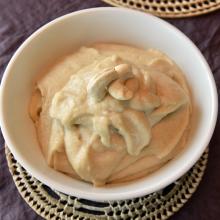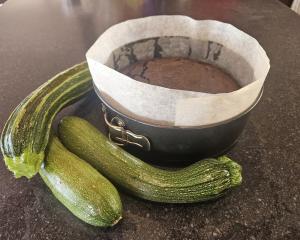Plants are the future, and they taste pretty good too, Hagar Ozri writes.
Whether it is to help mitigate climate change or adapt to its effects, a change in our behaviour is needed, now. We need to adopt a new diet, a plant-based diet!
National Geographic carried an interesting story earlier this year on the "Evolution of diet", making connections between traditional hunter-gatherer diets and the rise of vegan diets today.
We think of the diets of our ancestors from pre-history to be meat Monday to Sunday, but they actually ate a lot of plants.
As National Geographic explained: "... It turns out that ‘man the hunter’ is backed up by 'woman the forager', who, with some help from children, provides more calories during difficult times. When meat, fruit, or honey is scarce, foragers depend on 'fallback foods'."
There’s good evidence of this from peoples who continue to practise traditional ways.
"... The Hadza get almost 70% of their calories from plants. The Kung traditionally rely on tubers and mongongo nuts, the Aka and Baka pygmies of the Congo River Basin on yams, the Tsimane and Yanomami Indians of the Amazon on plantains and manioc, the Australian Aboriginals on nut grass and water chestnuts ... If most of the world ate more local fruits and vegetables, a little meat, fish, and some whole grains (as in the highly touted Mediterranean diet), and exercised an hour a day, that would be good news for our health — and for the planet."
It is clear that our species is good at adapting our diet to the demands of our environment. To me, that’s a real positive in this time of "climate anxiety".
The recipes that follow show how simple to prepare (and delicious) meals can be by using whole-foods and seasonal ingredients grown and produced in our own community.
Enjoy!
 Vegan patties in tomato sauce
Vegan patties in tomato sauce

This is a recipe for Moroccan fish-cakes made vegan, which my sister in-law gave to me, and it is an absolute stunner! It’s a good example of traditional recipes that are adapted to the new circumstances.
Remember to use locally made tofu, from the farmers’ market or the local Asian grocery store.
Serves 4
For the balls (patties)
300g tofu processed in a food processor until smooth
3 Tbsp bread crumbs
1 bunch fresh coriander
1 small red onion, finely chopped
1 garlic clove
4 Tbsp olive oil
1 level Tbsp ground cumin
1 level tsp paprika
1 tsp salt
For the sauce
¼ cup olive oil
10 garlic cloves chopped
1 red pepper thinly sliced
1 carrot thinly sliced
1 hot chilli pepper chopped
1 bunch coriander (leaves and stems included)
6 ripe tomatoes quartered
2 Tbsp paprika
1 tsp salt (or to taste)
½ to 1 litre water
Method
Heat oven to 200degC.
Mix all the patty ingredients in a bowl and form small round balls (size of ping-pong ball), place on a baking sheet, drizzle with olive oil and bake for 15min.
To make the sauce:
Heat the oil in a pot, fry all ingredients (except tomatoes and spices) for 5min.
Add tomatoes and spices and fry for 5min more, add ½ litre water and bring to boil, lower heat and cook for 20min. Add the baked patties to the sauce and continue to cook gently for 10 min or until hot.
Add more water if needed.
Serve with fresh coriander.
 Strawberry and fruit pie in nut-pastry
Strawberry and fruit pie in nut-pastry

This is a simple and most delicious fruit pie that can be made with any fresh fruit combo you desire. Arrange the fruit decoratively; unleash the artist in you!
As this fruit pie is a no-bake filling in a baked nut crust, allow enough time for the crust to cool completely before adding the filling.
For the nut pastry
½ cup wholemeal pastry flour
¾ cup rolled oats
½ cup finely chopped toasted almonds, walnuts or sunflower seeds (or any nuts you like)
½ tsp ground cinnamon or ¼ tsp ground cardamom
Pinch of sea salt
¼ cup olive oil (or fruit seed oil of your choice — grape seed is good)
3 to 4 Tbsp maple syrup or rice syrup
1 to 2 Tbsp water
Method
Brush inside of pie dish with oil. (I recommend using a pop-out-bottom-style tart tin — so cutting the crunchy crust is easier.)
In a bowl blend the flour, oats, nuts, cinnamon and salt.
In a liquid measuring cup, thoroughly whisk together the oil and syrup (this can also be done in a blender).
Make a well in the centre of the dry ingredients and pour in the liquid.
Stir with a fork to form a course dough, adding water if the mixture seems dry ... be careful not to overmix.
Flour your hands and press the dough thinly into the bottom and sides of an oiled 23cm pie tin.
Press quite firmly to make the dough spread to cover the dish bottom and sides.
Patch any torn thin spots with dough pinched from the edges.
Bake at 180degC for 15-20min and let cool completely before adding the filling.
For the glaze
1 cup of apple juice
1½ Tbsp agar flakes or 3 Tbsp of tapioca flour dissolved to a paste in a little water.
3 Tbsp of freshly squeezed lemon juice.
1 tsp vanilla.
For the fruit filling
10 large ripe strawberries washed and cut in half
1 to 2 ripe kiwifruit sliced
½ to 1 cup blueberries
Method
To prepare the glaze, heat the apple juice in a small saucepan. Stir in the agar flakes or tapioca and simmer until dissolved, about 1 to 2 minutes. Transfer to a liquid measuring cup and stir in the lemon juice and vanilla.
Arrange the fruit in the crust, in concentric circles.
Start with the kiwifruit around the rim and strawberries in a circle inside of the kiwifruit.
Mound blueberries in the centre and dot them here and there around the strawberries and kiwifruit. The object is to fill the pie crust to the brim with fruit.
Once the glaze is at room temperature or cooler, pour it evenly over the fruit.
The glaze should be thin enough to seep between the fruit.
If the glaze becomes too thick to pour, return it to the pan and heat it slightly while stirring.
Allow the glaze to set at room temperature for about an hour. Keep the pie in the fridge if not serving straight away.
Serve at room temperature.
Serve with tofu cream or cashew whip.

1 cup raw unsalted cashews
¼ cup water, approximately
2 to 3 Tbsp maple syrup or rice syrup
1 tsp vanilla
Method
Coarsely chop the nuts in a blender. With the motor running, gradually add the water, 2 Tbsp maple syrup and vanilla. Taste and add more maple syrup if desired.
Continue blending until the mixture achieves a consistency similar to whipped cream.
Add a bit more water if needed.

500g tofu, drained and cut into chunks.
¼ cup maple syrup, or instead try 3 or 4 Tbsp of fruit sweetened preserves and some finely chopped citrus peel
1 Tbsp vanilla
Method
Put all ingredients in a blender and process until smooth.
Both cashew whip and tofu cream will keep in the fridge for up to one week.
 Water kefir with mint and lemon
Water kefir with mint and lemon

Water kefir is a probiotic tonic. It has a delicious dry-lemonade like flavour.
Drinking kefir is a great option for the festive season, when we want to keep healthy, but still hold a drink in our hand at a barbecue.
(To buy kefir grains please contact Hagar via her website.)
6 Tbsp water kefir grains
4 Tbsp raw sugar
1 Tbsp raisins
3 pieces of crystalised ginger
¼ to ½ a lemon, peeled if not organic
3 cups water
Pinch of baking soda
Method
In a 1 litre "Agee" jar place water and sugar, stir until dissolved.
Rinse the kefir grains in running water and add to the jar. Add baking soda, lemon, ginger and raisins.
Place the lid on tight and leave it on the kitchen bench to bubble away for 24-48 hours, depending on the ambient temperature. When the raisins float to the top the kefir is ready!
Scoop out the raisins and crystal ginger, squeeze the lemon into the kefir.
Pour the kefir into a bottle through a sieve, to collect the kefir grains, with the help of a funnel.
Add grated fresh turmeric and fresh ginger and place the bottle in the fridge.
Serve with a squeeze or slice of lemon, add some chopped mint and a couple of ice cubes.
Coming up
- Look out for my plant-based cooking classes in "The Valley Project Summer School", in Dunedin’s Northeast Valley during January.
- Also sustainable plant-based cooking workshop on January 25 at Aro Valley Community Hall, Wellington.
- Listen to Sustainable Gastronomy radio show fortnightly on Tuesdays at 10am on OAR (105.4FM) Dunedin or podcasts online at www.oar.org.nz.
- www.hagarozri.co.nz












